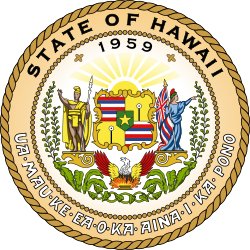This article needs additional citations for verification .(August 2025) |
| ||||||||||||||||||||||||||
| ||||||||||||||||||||||||||
 County Results Johnson 70–80% 80–90% | ||||||||||||||||||||||||||
| ||||||||||||||||||||||||||
| Elections in Hawaii |
|---|
 |
The 1964 United States presidential election in Hawaii took place on November 7, 1964. All 50 states and the District of Columbia, were part of the 1964 United States presidential election. Hawaii voters chose 4 electors to the Electoral College, which selected the president and vice president of the United States.
Contents
Hawaii was won by incumbent United States President Lyndon B. Johnson of Texas, who was running against Senator Barry Goldwater of Arizona. Johnson ran for a second time with Senator Hubert Humphrey of Minnesota, and Goldwater ran with U.S. Representative William E. Miller of New York.
This would be the first of three times Hawaii was won by a Democratic presidential candidate with over 70% of the vote, the other two times being Barack Obama - who was born in the state - in 2008 and 2012, although by around 7-8 points less than Johnson's victory. This would also be the only time that a candidate won Hawaii with over 75% of the vote.
President Lyndon B. Johnson won the State of Hawaii by an absolute sweep-out landslide of 57.6 percentage points. [1] It was the Johnson–Humphrey ticket's third largest margin in a single jurisdiction. [1] Since being granted votes in the Electoral College, no presidential candidate has ever won a larger percentage of the vote in the state than Johnson.


